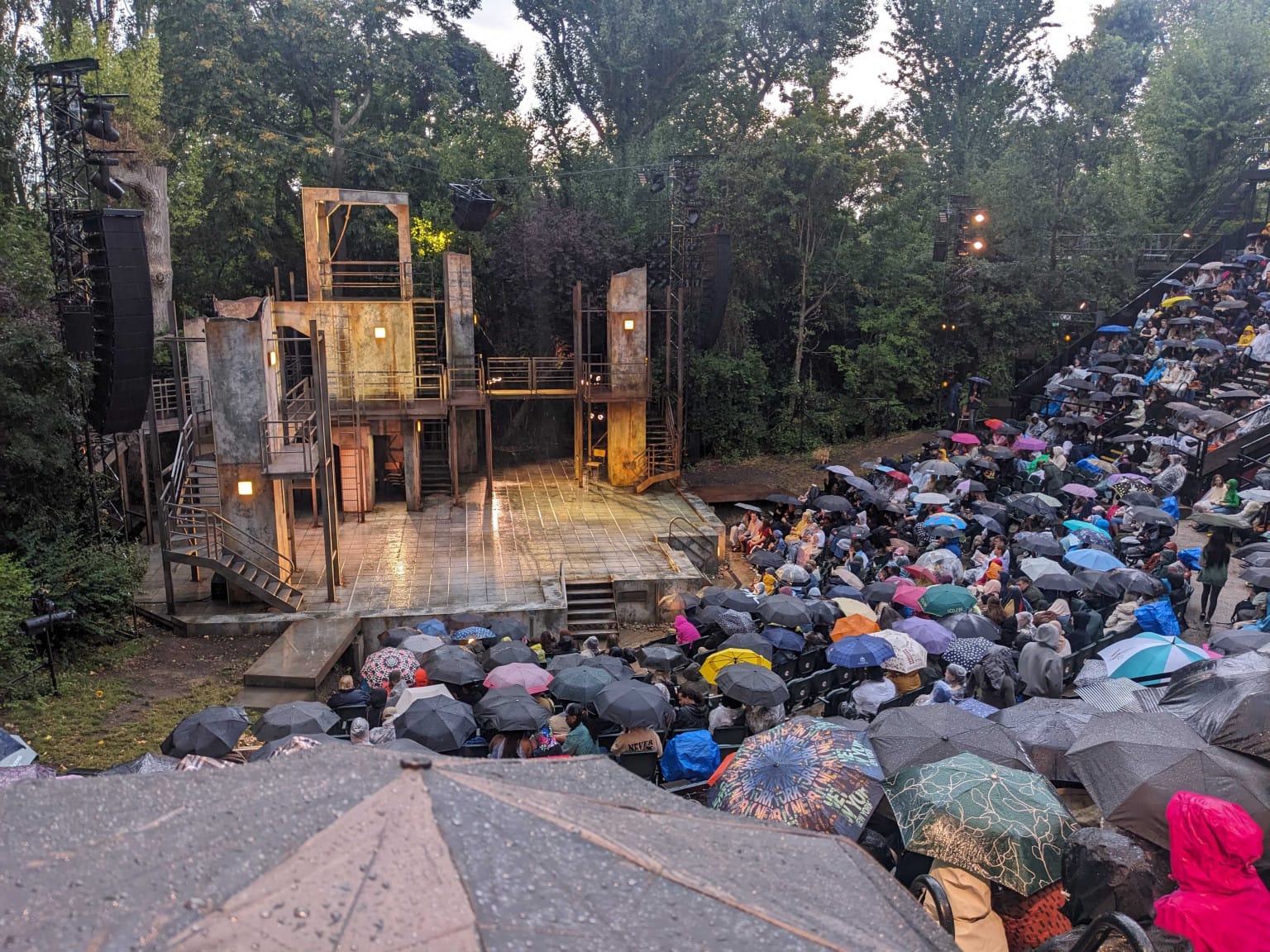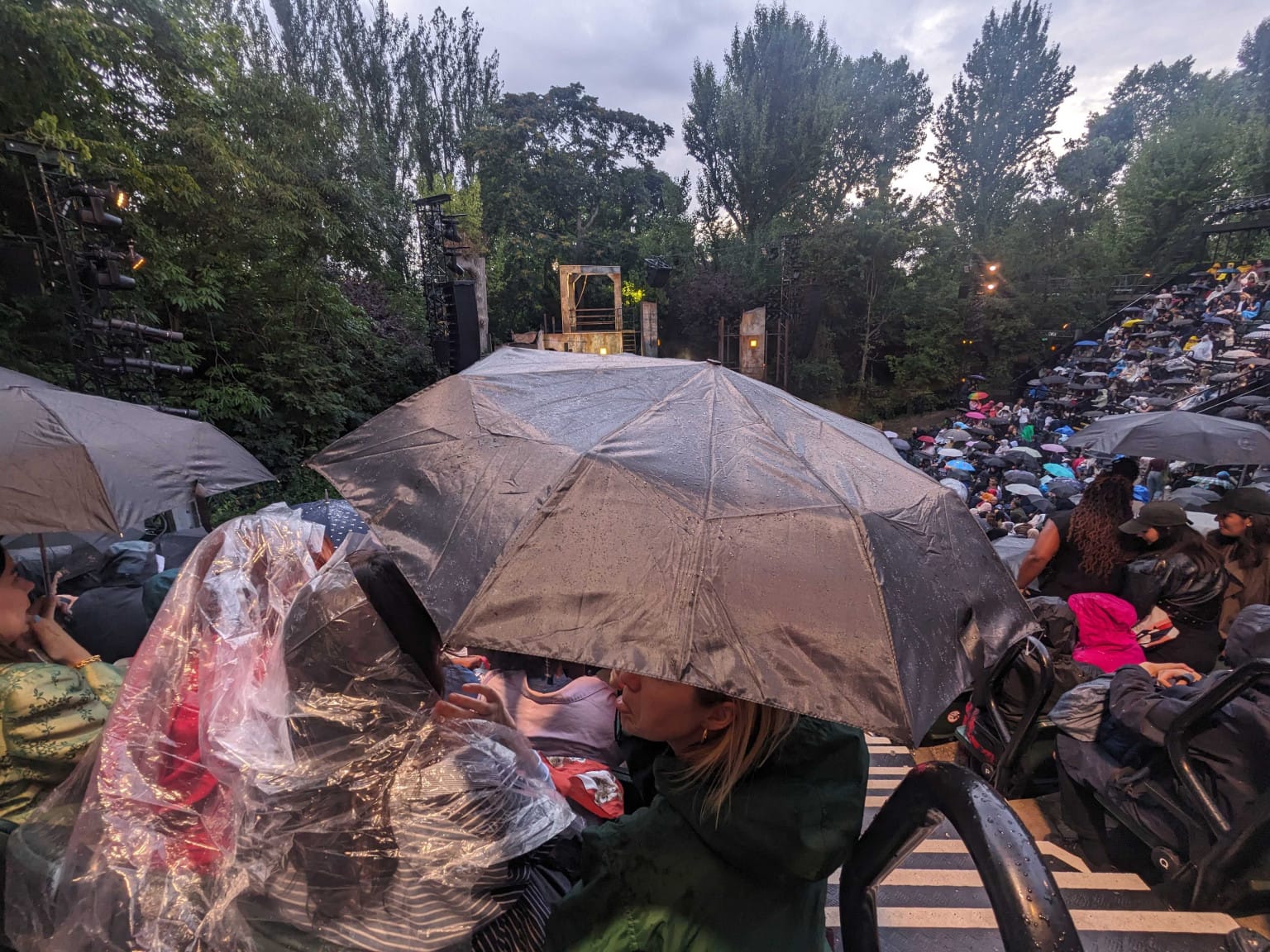Since Malorie Blackman’s Noughts and Crosses first came out in 2001, it’s become a beloved literary classic. I’d never read it growing up, so I couldn’t wait to check it out on the stage and review it…
Noughts and Crosses: The Cog Night Wasn’t

Well unfortunately the whole show got rained off so I never got to see the play. But don’t worry: it’s fine to have an opinion about something you haven’t actually watched (thanks Oscar voters), and my English degree means I have plenty of practice in writing about things that I haven’t really read.
Summer in London can be fantastic, with long, sunny days, beautiful green spaces and a fantastic cultural programme on offer. Prime among these, Regent’s Park Open Air Theatre has been serving up shows for years from an idyllic spot in the centre of one of London’s loveliest parks. When we started planning July’s Cog Night, the UK was right in the middle of a heatwave and heading for its hottest summer of all time, so we jumped at the chance to see a show in a relaxed outdoor setting.
 Manifesting positivity: Justin and colleagues tried to will the bad weather away
Manifesting positivity: Justin and colleagues tried to will the bad weather away
From its origins as a young adult novel, Noughts and Crosses has turned into a phenomenon, spawning multiple sequels, a BBC TV series, and a host of stage adaptations. Derby Theatre performed a version in 2019, and are bringing it back to the stage next year. But the version playing at Regents Park used the Royal Shakespeare Company’s acclaimed 2008 adaptation for its source material.
The story is set in an alternative 21st Century Britain where racial segregation exists between the the dark-skinned Crosses, who control society, and the light-skinned Noughts, who are exploited and treated as second class citizens. It’s a provocative idea, acknowledging and intentionally inverting historic examples of state enforced segregation from America in the ’50s or South Africa until the ’90s. The central romance of the story cuts across these boundaries, and has drawn comparisons to Shakespeare’s Romeo and Juliet, in its portrayal of two young lovers who are kept apart by differences imposed by family and society.
It sounded great, and we eagerly booked tickets, looking forward to an entertaining evening amid sun-kissed surroundings. But let’s not kid ourselves, you can’t trust the British weather. Like an egg mayo sandwich at a buffet, even when it looks good, you know it’s going to turn. The first inklings of concern entered my mind as a dark bank of cloud passed over Greenwich around mid-afternoon, and I remembered the last time the Cog team tried to watch an outdoor theatre show: only Alex lasted the duration at a soggy Globe for Richard III.
By 5 O’Clock the weather was about as bad as it could possibly be without actual rain pouring from the sky. As we headed up to Baker Street, only a short walk from Regent’s Park, I started discretely checking the cancellation conditions for the event on the venue’s website. I couldn’t get a conclusive answer about how much rain is too much, but I did find out that shows are automatically stopped if the temperature is over 40C … not much chance of that.
After a quick detour to fuel up on pizza we made our way to the theatre; by now it was raining heavily and a wash out was on the cards, but our spirits jumped when we got into the venue grounds. The area outside the auditorium was a lovely, cosy space (thankfully well sheltered from the rain), and as we made our way to the our seats we finally got our first view of the stage. Even with the poor weather the view was impressive, with Regent’s Park and the London cityscape stretching out into the distance beyond the performance area. The stage itself was a multi-level maze of platforms and rails. It looked fantastic, but it was clearly going to be an absolute death trap for the actors in this weather. And this wasn’t the kind of show where I’d be allowed to laugh at people falling over on stage.
 Death trap: the stage looked spectacular but the wet weather made it perilous
Death trap: the stage looked spectacular but the wet weather made it perilous
 Like Digbeth coach station: Justin didn't enjoy waiting for the play to start
Like Digbeth coach station: Justin didn't enjoy waiting for the play to start
After the initial excitement of seeing the venue, the waiting began. With fresh rain showers coming in every few minutes, our spirits were starting to dampen. The beleaguered stage manager popped up a few times with promises of better weather, but the mop in his hand was telling a different story, and we sensed we were in for the long haul. The whole situation was starting to remind me of the evening I’d just spent sitting in Digbeth Coach Station waiting for a ride out of Birmingham. The view was better, but at least Digbeth was dry. After about 40 minutes I sensed a dip in enthusiasm as theatre-goers started recalculating their journeys home. Then the inevitable cancellation was confirmed by the stage manager, cueing a rush for the exits. Most people seemed be looking on the positive side as they headed out of the park, but maybe they were just accepting their fate. No matter how much good weather we get, wet London always feels like the normal version London to me. It would have been nice to see the show, but in the end there was something nice and almost reassuring about the shared experience of yet another rainy evening in the capital.
 Obstructed view: when the umbrellas went up Justin couldn't see a thing
Obstructed view: when the umbrellas went up Justin couldn't see a thing
Illustration by Yufei Yang for our Cultural Calendar.


